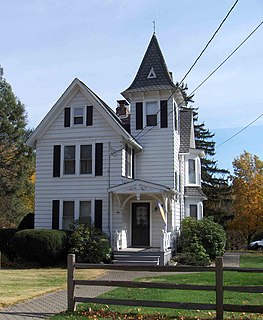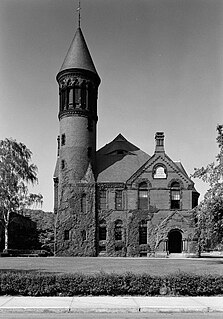A mill town, also known as factory town or mill village, is typically a settlement that developed around one or more mills or factories, usually cotton mills or factories producing textiles.

The Boston Manufacturing Company was a business that operated one of the first factories in America. It was organized in 1813 by Francis Cabot Lowell, a wealthy Boston merchant, in partnership a group of investors known as The Boston Associates, for the manufacture of cotton textiles. It built the first integrated spinning and weaving factory in the world at Waltham, Massachusetts, using water power. They used plans for a power loom that he smuggled out of England as well as trade secrets from the earlier horse-powered Beverly Cotton Manufactory, of Beverly, Massachusetts, of 1788. This was the largest factory in the U.S., with a workforce of about 300. It was a very efficient, highly profitable mill that, with the aid of the Tariff of 1816, competed effectively with British textiles at a time when many smaller operations were being forced out of business. While the Rhode Island System that followed was famously employed by Samuel Slater, the Boston Associates improved upon it with the "Waltham System". The idea was successfully copied at Lowell, Massachusetts and elsewhere in New England. Many rural towns now had their own textile mills.

The American Precision Museum is located in the renovated 1846 Robbins & Lawrence factory on South Main Street in Windsor, Vermont. The building is said to be the first U.S. factory at which precision interchangeable parts were made, giving birth to the precision machine tool industry. In recognition of this history, the building was declared a National Historic Landmark in 1966. In 1987, the building was recognized by the American Society of Mechanical Engineers as an International Heritage Site, and the collection was recognized as an International Heritage Collection. For each of these designations, the armory was considered a site where pivotal events occurred in the history of American industry, as well as a place that lends itself to comprehensive interpretation of that history.

Two 19th century factory buildings are sited on a bank beside Starr Mill pond on Beverly Heights just off Middlefield Street. Each building is 3½ stories tall, and overlooks a picturesque pond and woods to the west; a parking lot packed with trucks and industrial equipment on the south; and nineteenth century housing on Beverly Heights to the north.

Several neighborhoods of Norwich, Connecticut maintain independent identities and are recognized by official signs marking their boundaries. The following is a list of neighborhoods in Norwich.

The Georgetown Historic District is a historic district which covers the central portion the village of Georgetown, Connecticut. The district includes parts of Georgetown in the towns of Redding, Weston, Wilton, and Ridgefield and consists of the former Gilbert & Bennett manufacturing plant, institutional housing built for the plant workers, other private homes, and the Georgetown business district.

The Riverton Historic District is a historic district in the town of Barkhamsted, Connecticut that was listed on the National Register of Historic Places in 2007. It encompasses most of the historic 19th century industrial village of Riverton, whose mills were powered by the waters of the Still River and the East Branch Farmington River, which is located in the far northwestern corner of the town.

Mill Conversion or mill rehab is a form of adaptive reuse in which a historic mill or industrial factory building is restored or rehabilitated into another use, such as residential housing, retail shops, office, or a mix of these non-industrial elements (mixed-use).

Norwichtown is a historic neighborhood in the city of Norwich, Connecticut. It is generally the area immediately north of the Yantic River between I-395 and Route 169.

Marion is a neighborhood in the town of Southington in Hartford County, Connecticut, United States. It is generally the area in the vicinity of the intersection of Route 322 and Marion Avenue just north of the Cheshire town line.

The Chelsea Parade Historic District encompasses a predominantly residential area north of downtown Norwich. Centered around the Chelsea Parade, a triangular public park, the area has long been a preferred residential area for the city's upper classes, and includes a catalog of architecture from the 18th to 20th centuries. It includes 565 contributing buildings, two other contributing sites, and six contributing objects over an area of 205 acres (83 ha). The district was listed on the National Register of Historic Places in 1989.

The Downtown Norwich Historic District is a historic district representing the core of the downtown area of the city of Norwich, Connecticut in the United States. It was listed on the National Register of Historic Places in 1985. It includes 115 contributing buildings and one other contributing structure over a 64-acre (26 ha) area. Several buildings in the historic district are also individually listed on the National Register, including the Norwich Town Hall, the Telephone Exchange Building and the Carroll Building.

The Carroll Building in Norwich, Connecticut, also known as the Flat Iron Building, was built in 1887. It was listed on the National Register of Historic Places (NRHP) in 1982. It is included in the Downtown Norwich Historic District, which is also listed on the NRHP. Originally used as offices and retail stores, the building is now currently used primarily as an apartment building. The Carroll Building is located on a triangular tract created by the intersection of Main and Water Streets. The building is highly visible from Washington Square and is one of the most noticeable aspects of the downtown streetscape. The building is currently vacant.

The Yantic Falls Historic District encompasses a historic mill and associated worker housing on Yantic Street in Norwich, Connecticut. The 10-acre (4.0 ha) area includes a complex of mill buildings, mainly built in brick, and mill worker housing, also out of brick. The area's industrial history dates to the early 19th century. The district was listed on the National Register of Historic Places on June 28, 1972.

The Valley Falls Cotton Mill Site is the site of a historic mill at Valley Falls Park in Vernon, Connecticut. Mills were operated on the site from colonial times until 1877, when the last mill burned. The site was listed on the National Register of Historic Places in 1997.

Blackstone River Valley National Historical Park is a National Park Service unit in the states of Rhode Island and Massachusetts. The park was created for the purpose of preserving, protecting, and interpreting the industrial heritage of the Blackstone River Valley and the urban, rural, and agricultural landscape of that region. The Blackstone River Valley was the site of some of the earliest successful textile mills in the United States, and these mills contributed significantly to the earliest American Industrial Revolution. The subsequent construction of the Blackstone Canal, a few years after the successful completion of the Erie Canal, helped to sustain the region's industrial strength.

The Clark Brothers Factory No. 1 was a historic industrial complex at 1331 South Main Street in the Milldale area of Southington, Connecticut. Developed beginning in the 1850s, it was one of the nation's largest sources of carriage bolts. The complex listed on the National Register of Historic Places in 1988 consisted of a group of brick buildings dating to 1893 and later. It has since been entirely demolished, and the land stands vacant and overgrown.

The Bellows Falls Neighborhood Historic District encompasses a residential area of the village Bellows Falls, Vermont. Located south of downtown Bellows Falls, the area has one of the largest concentrations of well-preserved 19th century residences in southern Vermont. It was listed on the National Register of Historic Places in 2002, and enlarged in 2007.

The George–Pine–Henry Historic District encompasses a residential area of the village Bellows Falls, Vermont. Located west of downtown Bellows Falls, the area has a significant concentration of well-preserved late 19th and early 20th-century residences. It was listed on the National Register of Historic Places in 2010.

The Cargill Falls Mill, also known historically as the Wilkinson Mill, is a historic textile mill complex at 52-58 Pomfret Street in Putnam, Connecticut. Founded in 1806, it is one of the state's oldest mill complexes, and it retains examples of mill architecture spanning more than 175 years. It was listed on the National Register of Historic Places in 2014.



















